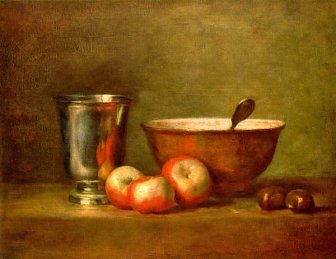 We usually see the pictures hanging on our walls only out of the corner of an eye as we’re hurrying past them. But every once in a while, we pause, look up from our busyness, and find ourselves drawn to one of them.
We usually see the pictures hanging on our walls only out of the corner of an eye as we’re hurrying past them. But every once in a while, we pause, look up from our busyness, and find ourselves drawn to one of them.
One of the things that distinguishes painting from the other arts is that it invites us to become still. A painting moves us by first stopping us in our tracks.
Jean-Baptiste-Siméon Chardin’s The Silver Goblet exemplifies how a painting does this. It stops our use of the things it pictures and invites us to see them as if for the first time. Ordinarily, we don’t take time to heed such objects. But here a providential light allows them to reveal themselves to us by uniting them in silent rapport. A curving line joins the three apples to the edge of the bowl and to their reflection in the goblet. The circularity of light and line creates a kind of stillness. The artist hasn’t arranged this stillness; he simply testifies to it.
Paintings such as this evoke gratitude for the commonplace. Chestnuts, ripening apples, a bowl—these are all everyday things. Chardin could have found them almost anywhere. His painting is profoundly democratic: irrespective of our class or rank, these are the kinds of things on which all of us rely. Need is the great leveler. Without these apples, without the bread made in this bowl, the fragile thread of life would break.
But there is something in the painting that cannot be explained by need: the goblet to which its title draws our attention. It is emphatically not necessary. Next to the commonplace simplicity of the bowl, the brilliance of the goblet is an indulgence that seems out of place. Chardin is known as a painter of the bourgeois interiors that were becoming socially significant in mid-eighteenth-century France. This goblet, we may surmise, is a bit of bourgeois ostentation. So too, we may be inclined to think, is the painting.
But when one looks at the earliest human artifacts—the jugs and bowls of so called “primitives”—one almost always finds an aesthetic element that transcends the object’s use. We customarily describe this element as “decorative.” But what we call “decoration”—lightning-like streaks of white on a black bowl, a rhythmic run of red triangles around the sides of a pitcher—can be transformative: it can turn what would otherwise be a mere tool into a palpable grace. Even in the most primitive human artifacts, something more than necessity is at play.
This something is beauty. Beauty is not for use. It embodies the holy. Chardin’s goblet, like a “primitive” pitcher, may hold the water needed for life; but life itself, like beauty, is not a necessity. It is the absolute surprise. Life isn’t valuable because it’s good for something else. It is good in itself. It is the original gift, the primal grace.
Great paintings stop us like a Sabbath. In every religious tradition, there are Sabbath times that interrupt what would otherwise be a never-ending cycle of work. The Sabbath is, first and foremost, a time of leisure, which begins with doing nothing. Experiencing a painting does not require us to do anything except allow ourselves to be moved by it. We can, for a short while, imitate the stillness of apples. The painting would have us stay still until we are moved to say “Amen!” to what it shows us—until we offer a Sabbath prayer. A painting on our kitchen wall can stop us at any moment, like an unscheduled Sabbath. Stopping momentarily in front of The Silver Goblet, we can do nothing long enough to become grateful again for the common things it shows us. We can learn all the manners we’ll ever need from Chardin’s painting. His sublime courtesy is there in what we call his style—something humble and unassuming, like the meekness of saints.
Chardin’s painting reminds us that existence is miraculous. We did nothing to deserve our birth. In our first nakedness, our original poverty, we come to the table empty-handed. All that we need—and more than we need—is given to us. The least we can do is to pay the gift some attention. After pausing to see the painting, we’re sucked back into the to-and-fro of our everyday routines. Like the quiet, unobtrusive light that suddenly reveals an unsuspected radiance in ordinary objects, the experience of grace is often brief. But the memory of the experience, a trace of its stillness, lingers—and summons us to a new way of seeing. It would be good to live as Chardin paints.

